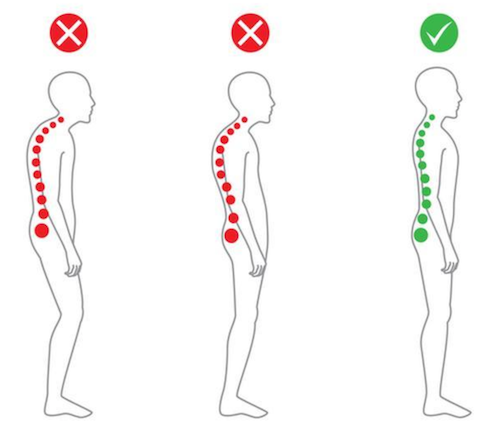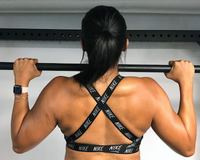
The Pronated Pull Up
Also known as the overhand pull up, the pronated pull up is an intense bodyweight lat exercise.
This compound exercise can completely transform your upper body strength.
If you want to build a bigger back, increase your functional strength, and test your mental fortitude, the pronated pull up is for you!
MUSCLES WORKED BY THE PRONATED PULL UP
PRIMARY MUSCLE GROUPS:
The pronated pull up primarily works your lats.
Originating in the mid-low back, the latissimus dorsi is the broadest muscle in your back.

Your lats activate to stabilize your back, as well as to depress, extend, and rotate your shoulders.
They play a significant role in most “pulling” exercises such as the lat pulldown, all pull up variations, and other rowing exercises.
SECONDARY MUSCLE GROUPS:
The pronated pull up secondarily works a variety of muscles in your back such as the rhomboids, the teres major, the traps, and more.
This exercise activates the brachioradialis in your forearm, as well as your biceps and brachialis, a muscle that lies beneath your bicep in your upper arm.
Lastly, the pronated pull up works smaller muscles around your shoulders such as the posterior deltoids.
Your deep core muscles (i.e., the transverse abdominis) also engage to stabilize your midsection.

PRONATED PULL UP BENEFITS
1. STRONGER & BIGGER LATS
The pronated pull up is guaranteed to increase lat hypertrophy. This extra muscle mass will translate to increased lat strength as well.
A sturdy back is essential for improving your performance in athletics, other compound lifts, and simple day-to-day activities.
If you want to build a bigger, stronger back, look no further than the pronated pull up.
2. IMPROVED POSTURE
Hours of sitting in chairs at work or while driving can wreak havoc on your posture.
If you are not regularly exercising your back, these muscles can weaken, which can cause a slouched back position.
The pronated pull up can activate under-utilized muscles to help reduce back pain or discomfort.
With consistent exercise, you will be standing upright with proper posture in no time.

3. IMPROVED AESTHETICS
Most people tend to emphasize their “show” muscles such as the abs, chest, and biceps.
While there is nothing wrong with training these muscles, a balanced approach to building muscle is safer and more effective.
Not only is it safer, but if you really want to build that classic V-shape of the upper body, pronated pull ups are a great place to start.

HOW TO DO THE PRONATED PULL UP
EQUIPMENT:
For this exercise, you only need a pull up bar.
SETUP:
a) Grab the pull up bar with your hands roughly shoulder width apart and your palms facing away from you.
b) Make sure your back is straight and your feet are slightly in front of your body as you hang from the bar.
ACTION:
a) Bring your shoulder blades down and contract your lats to pull up until your chin rises above the bar.
b) Pause briefly at the top and squeeze your lats hard.
c) Slowly return to the starting position and repeat!
RECOMMENDATION:
You should aim to complete 3-4 sets of 6-12 pronated pull ups.
As you become comfortable with the pull up form, feel free to change up your set and rep ranges to challenge yourself.
PRONATED PULL UP MISTAKES
1. COMPLETING PARTIAL REPS
The most common pronated pull up mistake is failing to complete a full rep. Sometimes, lifters fail to pull all the way up above the bar.
Other times, they don't drop all the way down and fully extend their arms in the starting position.
Both of these mistakes remove tension from your back.
If you practice proper form, you will see the best possible results!
2. SWINGING BACK AND FORTH
Using momentum is another common pull up issue. While many CrossFit athletes may use a kipping motion to do more reps, this is not the best way to target your lats.
To stop yourself from swinging, keep your core engaged and your feet out in front of you. Focus on moving your body straight up and down on every rep.
3. USING YOUR ARMS TOO MUCH
Other weightlifters tend to over-utilize their arms during the pronated pull up at the bottom part of the motion.
While the biceps do play a supplementary role in the exercise, you don't want them to power the movement and take engagement away from the lats.
Be sure to initiate the pull up motion with your back first to perform the pronated pull up with proper form.
PRONATED PULL UP VARIATIONS
1. ASSISTED CLOSE GRIP PULL UP
If you can’t do any pull ups at all, start with the assisted pull up machine. Set up with your knees on the pad and grab the middle set of handles with your palms facing away from you.
Then, complete the pronated pull up with the same form as the bodyweight variation. Be sure to focus on your lats as you drive upwards.
Repeat!

2. PRONATED PULL UP HOLD
Adding a hold to the pronated pull up is the perfect advanced variation of the exercise.
Simply hold your position at the top of every rep for at least three seconds. Squeeze your back and biceps hard during each hold and return to the starting position.
You may not be able to do as many pull ups but you will definitely increase your time under tension.
3. SUPINATED PULL UP
The supinated pull up engages your biceps significantly more than the pronated pull up. For that reason, this variation may be a bit easier for you.
To begin, grab the pull up bar with your hands shoulder width apart and your palms facing towards you. Then, complete the supinated pull up with the same form as the pronated variation.
PRONATED PULL UP ALTERNATIVES
If you enjoyed the pronated pull up, check out these other back exercises to improve your upper body training:
1. WIDE GRIP LAT PULLDOWN
Sit down facing the cable machine. Use the knee pads to lock in your legs and secure your knees directly above your ankles. You want to make sure your lower half is stabilized.
Extend your arms upwards to grab the bar at the widest grip position with your palms facing away from you. Your hands should be wider than shoulder width apart.
While slightly leaning back, brace your core, bring your shoulder blades down and back, and pull the bar down until it touches the top of your rib cage. Pause briefly at the bottom, squeeze your lats, and slowly return to the starting position.
Maintain tightness in your core and repeat!
2. OVERHAND BARBELL ROW
Set up a barbell on the ground with light to medium weight. Assume a standing position with your feet shoulder width apart. Step forward so that the barbell is over the middle portion of your feet.
Grab the bar with an overhand grip with your hands just outside your knees. Brace your abs and back and lift the barbell off the ground until you are in a standing position with your back straight.
Keeping your abs and back tight, hinge your hips backwards until your back is nearly parallel to the floor. Extend your arms straight down and keep your gaze focused a few feet in front of you.
Keeping your elbows tucked, drive your elbows up and back to bring the barbell up towards your belly button. Squeeze your lats at the top, pause for a moment, and slowly return to the starting position.
Maintain tightness in your core and back and repeat!
3. WIDE GRIP SEATED LOW ROW
Sit on the bench with your back straight and your feet planted on the foot pads. Extend your arms and grab the lat bar with your palms facing down and your hands wider than shoulder width apart.
Retract your shoulders, brace your abs, and pull the handle into your abdomen. Pause for a moment, then slowly return to the starting position. Repeat!

WANT TO DO MORE PULL UPS?
Check out these 7 key tips to increase your pull ups today:
Join the Invasion!
This Anabolic Aliens membership will grant you access to workout classes, rehab programs, diet plans, and more exclusive content to help you achieve sustainable success!

















